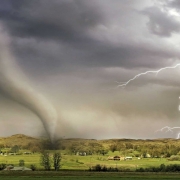Extreme weather affects nearly half of data centers
Recent extreme weather-related events in the US (the big freeze in Texas, fires on the west coast) have once again highlighted the need for data center operators to reassess their risks in the face of climate change. The topic is discussed in depth in the Uptime Institute report (available to Uptime Institute members) entitled, The gathering storm: Climate change and data center resiliency.
Data centers are designed and built to withstand bad weather. But extreme weather is becoming more common, and it can trigger all kinds of unforeseen problems — especially for utilities and support services.
In a recent Uptime Intelligence survey, almost half (45%) of respondents said they had experienced an extreme weather event that threatened their continuous operation — a surprisingly large number. While most said operations continued without problems, nearly one in 10 respondents (8.8%) did suffer an outage or significant service disruption as a result. This makes extreme weather one of the top causes of outages or disruption.

More events, higher costs
The industry — and that means investors, designers, insurers, operators and other contractors — is now braced for more challenging conditions and higher costs in the years ahead. Three in five respondents (59%) think there will be more IT service outages as a direct result of the impact of climate change. Nearly nine in 10 (86%) think that climate change and weather-related events will drive up the cost of data center infrastructure and operations over the next 10 years.
While most operators are very aware of the risks and costs of climate change, however, many do not appear to consider their own sites to be facing any immediate challenges. Over a third (36%) report their management has yet to formally assess the vulnerability of data centers to climate change. Almost a third (31%) believe they already have adequate protection in place — but it is not clear if this belief is backed by recent analysis.
Perhaps most dramatically, only one in 20 managers sees a dramatic increase in risks due to climate change and is taking steps to improve resiliency as a result. Such steps can range from simple changes to processes and maintenance to expensive investments in flood barriers, changes to cooling systems or even re-siting and closure.

The need for assessments
Any investments in resiliency need, of course, to be based on sound risk analysis. Uptime Institute strongly recommends that operators conduct regular reviews of climate change-related risks to their data centers. The risk profile for a data center may be far less rosy in 2021 than it was when it was built even a few years ago. Four in five data center operators (81%) agree that data center resiliency assessments will need to be regularly updated due to the impact of climate change.
As recent events show, such reviews may need to consider water and power grid resilience, potential impacts to roads and staff access, and even the economics of operating for long periods without free cooling.
The figure below shows the top areas typically reviewed by organizations conducting climate change/weather-related data center resiliency assessments.

Data center managers do appear to have a good understanding of what to assess. But the findings also highlight the Achilles heel of data center resiliency: the difficulty of mitigating against (or even accurately analyzing) the risks of failures by outside suppliers. Extreme weather events can hit power, water, fuel supplies, maintenance services and staff availability all at once. Good planning, however, can dramatically reduce the impact of such challenges.








 2020
2020 2020
2020 UI @ 2021
UI @ 2021 UI @ 2021
UI @ 2021